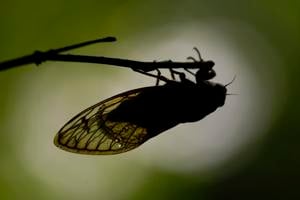WHEATON, Ill. — The most noticeable part of the cicada invasion blanketing the central United States is the sound — an eerie, amazingly loud song that gets in a person's ears and won't let much else in. “It’s beautiful chaos,” said Rebecca Schmidt, a U.
S. Department of Agriculture research entomologist. “It does make this kind of symphony.

” The songs — only from males — are mating calls. Each periodical cicada species has its own distinct song, but two stand out: those of the orange-striped decims or pharaoh cicadas, and the cassini cicada, which is smaller and has no orange stripes on its belly. “The one we’re hearing the most is the cassini, a buzzy trail that goes up in a wave and is coming back down,” Jennifer Rydzewski, an insect ecologist at DuPage County Forest Preserve, said as she spoke in a clearing near a grove of trees.
“And every time it goes up in a wave and comes back down, you’ll see in the treetops a bunch of them start flying out, so they’ll make a call and then jump to a new branch and make the call again. So it’s actually like different groups that are coming in waves.” The other one is a “constant whirring hum, which is the pharaoh's staccato,” and every now and then an individual call that sounds like “eee-ooo” can be heard, she said.
Others have said the sound is more like “fffaaaro, fffaaaro.” The sound comes from a white membrane on the male's midsection that is made to vibrate, Schmidt and Rydzewski said..
















